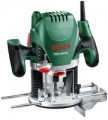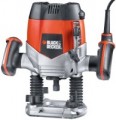Min. speed
The slowest spindle speed (in revolutions per minute) provided by the router motor.
For different jobs, the optimal spindle speed (and, accordingly, the cutter) will also be different. For example, hard materials like stone require fast rotation, but wood does not; some types of nozzles work better at high speeds, others at low speeds, etc. Detailed recommendations for each specific case can be found in special sources. Here we note that the smallest value of the minimum number of revolutions found in modern milling cutters is about 3000 – 5000, and in the most "fast" models this figure can exceed 15000. When choosing, pay attention not so much to the minimum rotation speed as to the total speed range — how it corresponds to the planned tasks.
Max. cutter diameter
The largest diameter of the cutter that can be installed in the router.
The larger the cutter, the faster its cutting edge moves and the more material it can capture, but larger nozzles require more torque. Accordingly, the maximum diameter of the cutter is directly related to the power of the tool (see above): the larger the allowable size of the nozzle, the more powerful and advanced, usually, the router is. However, large cutters (as, in fact, high power) are not always really needed. Therefore, when choosing according to this parameter, it is worthwhile to adequately evaluate the upcoming work and not chase the maximum size.
In box
Additional equipment included in the delivery of the router in addition to the device itself.
—
Fresa. Working nozzles — milling cutters — can be included in the delivery set of milling cutters, this eliminates the need to purchase such nozzles separately. On the other hand, before buying a tool with this feature, you should make sure that the complete cutters correspond to the features of the planned work — otherwise you may overpay for unnecessary nozzles. Usually, there are several cutters in the set.
—
Dust collector. A special container for collecting dust, sawdust and other debris generated during the operation of the router. Most often it is made in the form of a soft bag, and a special pipe is used to connect to the tool (a vacuum cleaner can also be connected through the same pipe). Note that the overwhelming majority of modern milling cutters are equipped with nozzles for dust collectors, but the bags in the kit are relatively rare. Usually, a dust bag can be purchased separately, but for some users it is preferable to immediately buy a tool with a bag.
—
Copy base. The copy base is the base (sole) of the router (see "Type"), specially designed to work with copy sleeves. The copy sleeve is a ring fixed on the tool body, into which the cutter is threaded. When working with such a sleeve, the operator rests the outer edge of the ring agai
...nst the template and moves the tool in such a way that the base is constantly pressed against the template. Thus, the distance between the cutter and the template remains unchanged, and the working nozzle repeats the shape of the template; this is indispensable for precise work, especially with lines of complex shape. Many routers allow you to install a copy sleeve on a regular sole, however, there are models in which you need to install a special copy base for this. Such a base has certain differences from the standard one, due to the specifics of the work — in particular, it usually does not have depth adjustment, because. the presence of an adjustment mechanism can adversely affect the accuracy of work.
— Protective limiter. The protective limiter is a small ring that covers the working nozzle. This ring, as the name suggests, provides additional protection for the operator from dust, chips and other debris generated during operation. In addition, it prevents foreign objects (primarily fingers) from getting under the cutter and increases the efficiency of collecting debris in a vacuum cleaner or dust collector (see above). And so that the operator can control the process of work at the same time, the protective limiter is usually made transparent.
— Guide rail. A device designed primarily to ensure that the router during operation can move parallel to the edge of the material being processed. The rail rests against this edge during operation, and the tool itself extends a certain distance from it on special guides. Thus, it is possible to cut recesses parallel to the edge of the workpiece. The distance from the rail to the cutter can be adjusted, some models even provide special scales on the rail itself.
— Case / bag. This category includes all devices designed for storing and transporting tools; at the same time, hard containers in the form of characteristic suitcases are usually called cases, while bags, on the contrary, are made of soft materials. Anyway, the case / bag simplifies storage and carrying: firstly, due to the fact that such devices themselves are more convenient for long-term carrying than a tool; secondly, due to the fact that the router, the power cord, and all additional accessories can be folded into one place, reducing the risk of losing any of it.Power cord length
The length of the power cord provided in the design of the router.
The long cord, on the one hand, allows the tool to easily “reach” quite remote sockets, provides additional freedom of action and eliminates the need to switch to another socket once again. On the other hand, it can be inconvenient if the power source is not far away and the excess cord has to be stored on the floor, chair, etc.; and with insufficient length, it is quite possible to use an extension cord. Therefore, in most modern routers, the length of the cord is about 2 – 4 m — this is quite enough to reach the outlet in most cases, and at the same time not so much that there is inconvenience due to the large excess.
Noise level
The noise level produced by the router during operation. This parameter is quite approximate, since the actual “loudness” depends not only on the characteristics of the tool itself, but also on the material and shape of the workpiece being processed, the type of cutter, the speed of work, etc. Therefore, in fact, the noise level may differ both up and down; in the characteristics, a certain average value is given, by which, however, it is quite worthwhile to navigate.
The “quieter” the tool, the more comfortable it will be to work with it, the less likely it is that the operator will need protective headphones. At the same time, we note that routers, by definition, are quite noisy — the most “quiet” models give out about 75 dB. Also, keep in mind that the decibel is a non-linear quantity, so it is best to use comparison tables when estimating the noise level.
Here is a simplified version of such a table for the range in which most modern routers operate:
75 dB — scream, loud laughter at a distance of 1 m;
80 dB — motorcycle engine, mechanical alarm at the same distance;
85 dB — a loud cry at the same distance;
90 dB — demolition hammer at a distance of 1 m, a freight car at a distance of 7 – 10 m;
95 dB — subway car (inside or at a distance of about 7 m).

